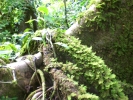 Burma's forest-covered area has reduced by 14 percent in 35 years, registering 40 percent of the country's total land area now, according to figures of the FAO available here Thursday. The percentage dropped from 60 percent in 1975 to 41 percent in 2010. Forestry experts attributed the depletion of forest mainly to the excessive extraction of timber.
Burma's forest-covered area has reduced by 14 percent in 35 years, registering 40 percent of the country's total land area now, according to figures of the FAO available here Thursday. The percentage dropped from 60 percent in 1975 to 41 percent in 2010. Forestry experts attributed the depletion of forest mainly to the excessive extraction of timber.
Myanmar possesses many kinds of natural forests such as fresh- water forest, salt-water forest, pine forest, deciduous forest, evergreen forest and so on.
Myanmar's forestry authorities have planned to reduce timber production and export during this fiscal year of 2010-11, in order to prevent forest depletion. They have also been implementing some reforestation projects by granting local private companies to grow teak and hardwood with land allotted for them for the purpose since 2005. The Myanmar authorities have been drawing a 30-year plan involving the participation of private companies. Plantations however hardly have the same ecological values of natural rainforsts.
According to the National Commission for Environmental Affairs (NCEA), the rate of forest depletion in Myanmar in 2000-05 was as high as 466,000 hectares, standing as the fourth most forest depleting country in the world after Brazil, Indonesia and Sudan.
There are 155,340 square-kilometers of reserve forests and protected public forests in Myanmar with 52,650 hectares of plantations, statistics show.


